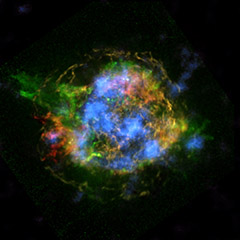 Cassiopeia A - NASA/JPL Caltech
Cassiopeia A - NASA/JPL Caltech
One of the big mysteries of our universe, how stellar explosions called supernovas occur, is being unraveled thanks to a new telescope developed by NASA/JPL-Caltech with contributions from RIKEN scientists.
NASA's Nuclear Spectroscopic Telescope Array, or NuSTAR, is the first telescope capable of producing maps of radioactive material in supernova remnants.
The telescope created the first-ever map of radioactive material in a supernova remnant, called Cassiopeia A (Cas A), which was created when a massive star exploded as a supernova about 350 years ago (at a distance of about 11,000 light years).
The map of Titanium-44 in Cas A reveals that Titanium is concentrated in clumps at the center of Cas A, which indicates that the star did not uniformly explode from the center, but that material sloshed around at the core of the explosion, allowing a shock wave to ripple to the outer regions, ripping the star apart.
“NuSTAR provides us with the first sharp image of the high-energy X-ray universe, and the Titanium-44 map in Cas A observed with NuSTAR clearly shows that the massive star exploded asymmetrically” explains Dr Takao Kitaguchi, a RIKEN scientist who worked on the development NuSTAR and analyses data obtained with the telescope. For more information, visit High Energy Astrophysics Laboratory webpage.
The findings are published in Nature, DOI: 10.1038/nature12997
